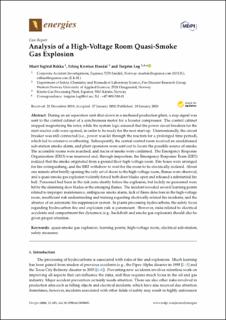| dc.description.abstract | During an air separation unit shut-down in a methanol production plant, a stop signal was sent to the control cabinet of a synchronous motor for a booster compressor. The control cabinet stopped magnetizing the rotor, while the system logic ensured that the power circuit breakers for the start reactor coils were opened, in order to be ready for the next start-up. Unintentionally, the circuit breaker was still connected (i.e., power was let through the reactors for a prolonged time period), which led to extensive overheating. Subsequently, the central control room received an unaddressed sub-station smoke alarm, and plant operators were sent out to locate the possible source of smoke. The accessible rooms were searched, and traces of smoke were confirmed. The Emergency Response Organization (ERO) was mustered and, through inspection, the Emergency Response Team (ERT) realized that the smoke originated from a ground floor high-voltage room. Fire hoses were arranged for fire extinguishing, and the ERT withdrew to wait for the room to be electrically isolated. About one minute after briefly opening the only set of doors to the high-voltage room, flames were observed, and a quasi-smoke gas explosion violently forced both door blades open and released a substantial fire ball. Personnel had been in the risk zone shortly before the explosion, but luckily no personnel were hit by the slamming door blades or the emerging flames. The incident revealed several learning points related to improper maintenance, ambiguous smoke alarm, lack of flame detectors in the high-voltage room, insufficient risk understanding and training regarding electrically related fire incidents, and the absence of an automatic fire suppression system. In plants processing hydrocarbons, the safety focus regarding hydrocarbon fire and explosion risk is paramount. However, risks related to electrical accidents and compartment fire dynamics (e.g., backdraft and smoke gas explosion) should also be given proper attention. | en_US |

